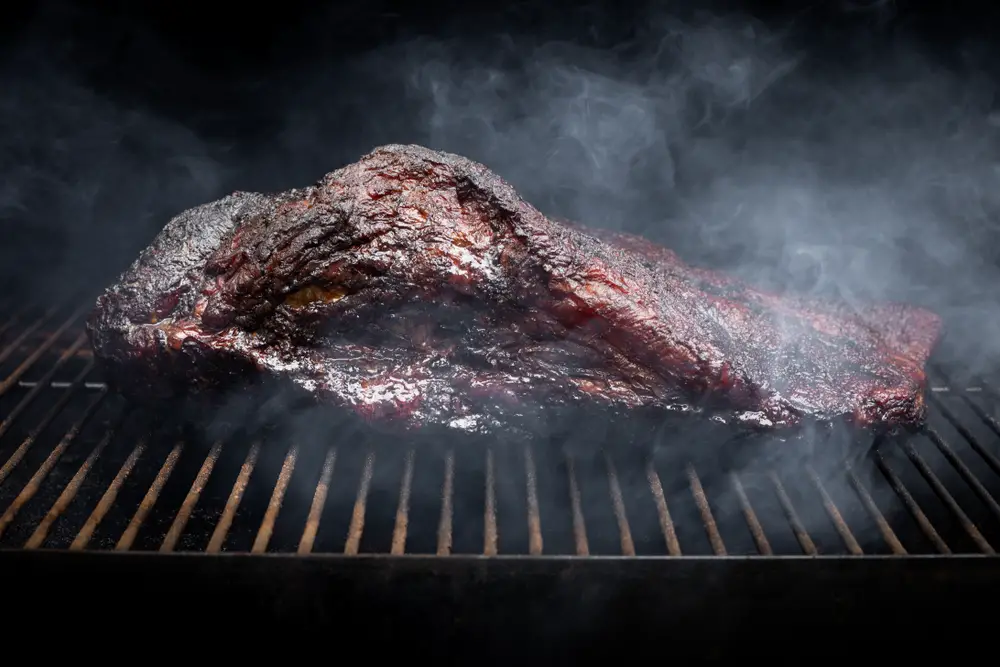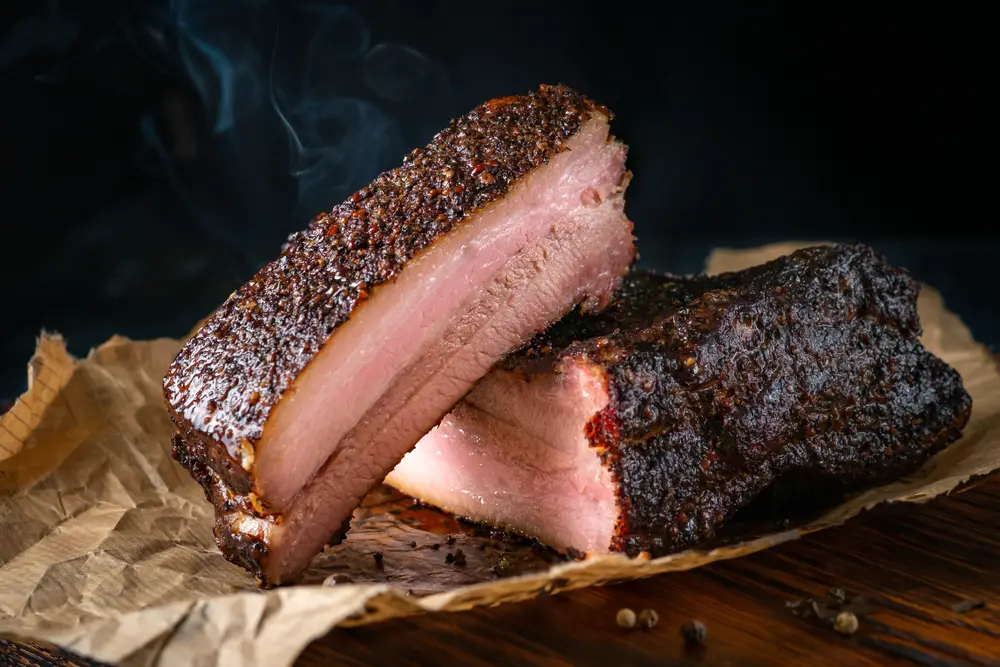
The idea that smoking is an unrefined art that’s based solely on letting your chosen smoker do all the hard work for you, is one of those urban barbecue legends that’s been perpetuated by cable television and the cooking shows that make everything look easy.
Smoking is all about finesse, about knowing how to apply heat and flavor and when you should and shouldn’t flip whatever it is you’re smoking.
Should you flip a brisket while you’re smoking it? Of course, you should. Ideally, you should flip your brisket two times, but as long as you flip it at least once after the bark is set, it’ll be filled with all of the dense, rich, smoke-filled flavors that you’re looking for, evenly cooked, and no pooling juices.
And we’re going to tell you why it’s important to turn your brisket while it’s smoking because the last thing that you want to end up serving your family and friends is a dried-out cut of meat that you drained your pocketbook to buy.
Flipping a brisket while you’re smoking it ensures that both sides of the meat are exposed to an equal amount of heat, which will result in a nice, even cook and make sure that the smoke has thoroughly infused the meat as well.
Another useful tip that we took to heart when it was first handed down to us and have adhered to rigidly ever since, is every time you flip your brisket while it’s smoking, spritz it.
A light spray of apple cider vinegar will help to prevent the meat from drying out and the moisture will trickle through every atom of your brisket and keep it succulent. Which is exactly how you’ll want it to be when you’ve finished cooking and turned the heat on your smoker off.
Note: most links in this article are Amazon.com Affiliate links, see Affiliate Disclosure, thank you.
Should I Wrap My Brisket In Foil When Smoking?
Whether you should or shouldn’t wrap your brisket while you smoke it is entirely dependent on the way texture and taste you want your brisket to have when finished.
Wrapping a brisket in foil or butcher paper is known as a “Texas Crutch”, and it’s an ideal way to speed up the time that it takes your brisket to cook, ensures an even distribution of heat throughout the meat, and makes sure that it’s moist, and will melt in your mouth when you eat it.
Essentially, by wrapping your brisket when you smoke it, you’re creating an oven within an oven and cooking your brisket in its own juices.
Even though it’s quicker and helps to navigate and avoid any of the temperature swings that smokers can be prone to suffer from, and you’re pretty much guaranteed a perfect cook, there are a few drawbacks to wrapping your brisket before you smoke it.
Wrapped brisket won’t develop that gorgeous, crunchy bark that a naked smoked brisket will because you’ve sealed in the juices causing steam to form. Additionally, smoke will no longer penetrate your brisket when wrapped tightly in foil or butcher paper.
If you want to add a little extra kick and flavor to a wrapped brisket, you’ll have to add the spices and anything else that you want to use to give it a taste lift before you wrap it.
The best time to wrap your brisket is when the internal temperature reaches 160 degrees, and increase your smoker temperature to 275 to speed up cooking.
So, whether or not you should wrap your brisket when you’re smoking it, is entirely up to you.
There are pluses and minuses and ticks and crosses in both smoking camps, so whether you choose to use a Texas Crutch or smoke naked is between you and your maker.
Just make sure you choose wisely and well and let your heart (and your stomach) guide your smoke instead of your head.
What’s The Best Wood To Smoke Brisket With?
We prefer to use pecan, as it adds a nutty, natural sweetness to brisket that’s the perfect accompaniment to a chili and cayenne rub.
That’s another of those “chicken and egg” questions that depend entirely on tastes and your geographical location.
Traditionally, Texas-style smoked brisket has always tended to lean heavily in the direction of Mesquite hardwood, as it has a naturally spicy twist, and in the Lone Star State, they tend to like brisket that kicks harder than an angry mule.
Then there are the die-hard, veterans of the grill who swear that the only wood that you should ever use to smoke any meat, brisket included, with is hickory.
It sounds a little weird given that hickory smoke tends to add a little bacon flavor, which pushes the flavor gradient in any cut of meat taken from a pig through the roof, to imbue beef with that sort of pork-friendly flavor profile, but it does work.
The truth is, despite what your brain is telling you right now, it works really well, and hickory-infused brisket is a taste that you’ll never forget for all of the right reasons.
As we said though, it’s all matter of taste, and before you set your heart firmly on one kind of wood and one kind of wood alone, may we humbly suggest that you before you make your mind up and fixate on a single variety, that you at least try smoking with all three kinds of wood that we mentioned?
The results might surprise you.
Check out our article How to Match Your Smoking Wood to Your Meat?

Do You Smoke Brisket Fat Side Up Or Down?
We prefer to start our brisket fat side up. This will allow the dry rub to form a nice crust and will enable the fat to drip through the meat as it renders, adding moisture and flavor to the brisket.
There is an argument to be made for placing the fat side down. As most smokers tend to heat from the bottom up, the fat acts as an insulating blanket for the brisket, making it easier to smoke the meat as it should be smoked - long, low and slow.
However, don’t overthink it, as you’re going to have to flip your brisket a couple of times while you’re smoking it to prevent it from drying out on one side and to let the fat ooze through the meat from the top down.
Which side you do or don’t start smoking it on doesn’t make a lot of difference to how it will taste when you’ve finished cooking, as long as you wait for the crust to form, and spritz your brisket if needed while it’s smoking.
Why Was My Brisket Tough After Smoking?
The main reason brisket may come out tough is because the internal temperature is too low. Your brisket should have an internal temperature of 195 when you remove it from your smoker. Then your brisket will need to rest for at least 30 minutes, but don’t be scared to rest for an hour in a dry cooler.
There can be other reasons it is dry because brisket is a notoriously tough cut of meat. Low and slow is the traditional school of thought, starting your smoker at 225 degrees.
However, cooking above this temperature can dry out your brisket and not allow the connective temperature time to break down. After your brisket reaches 160 degrees internal temperature, you can safely bump your smoker temperature up to 275 degrees.
We recommend that you check your thermometer to control for smoker temperature errors. You can do this by placing a glass of water in the smoke for an hour then using an instant-read probe thermometer to see if the reading match.
Sometimes you can get a brisket that has a low-fat content. If you have identified this issue, try injecting your brisket with flavored low-sodium beef stock. We recommend one 15oz can of stock and one cup of your favorite barbeque sauce for a tasty injection.
Where you put your brisket in your smoker can also cause a dry brisket. Usually, this only affects one side, commonly the flat side, but it can affect the point if it is undercooked. When you start your brisket, place the point end in the hottest spot and the flat end toward the coolest spot on your smoker grate.
There are still other factors that can lead to dry brisket, but these are the top few.
Should You Marinate A Brisket Before Smoking?
We recommend not marinating a brisket before smoking but instead using a dry rub. The two main reasons we like dry rub over marinade are crispy bark and fast preparation. A standard SPG rub will work great but don’t be scared to venture out with specialty flavors.
Whether you choose to use a rub on your brisket or marinate it before you smoke, it is entirely up to you. If you do decide to marinate it, be prepared for the extra time and effort that you’re going to need and will have to put into preparing your brisket before you smoke it.
If your heart is set on marinating your brisket before you smoke it, you’ll need to whip up the marinade and let your brisket soak in it, in a refrigerator, for around twelve hours before you do smoke it.
The soaking and time that it takes are one of the main reasons why most smokers choose to go with a rub rather than marinating brisket, as it makes it easier to handle and smoke, and you don’t have to plan and begin to do everything at least a day in advance of when you actually intend to start smoking.
At the end of the day though, it’s your brisket and you can smoke it any way that you want to.
Check out our article Is Dry Rub Better Than Marinade for Smoking?
Can You Smoke Brisket With Applewood?
You can use any wood you want to smoke your brisket, there are no set rules or parameters governing which wood you can and can’t use to smoke a brisket. There isn’t a rulebook that every smoker in the country has to defer to or obey when they set their smokers up.
If you want to smoke your brisket with Applewood, or use an Applewood rub on it before you start smoking, then by all means use either or both to add to and enhance the flavor of your brisket.
Applewood, as its name implies will imbue your brisket with a sweet, fruit flavor that works well and is favored by those smokers who don’t think that smoking should begin and end with either charcoal or hickory.
If you like your meat sweet, then there are far worse ways to chase that flavor profile, and Applewood should add all of the fruit taste that you’ve been craving to your brisket.
